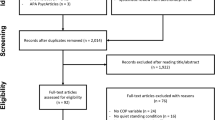Abstract
Background
Previous studies have demonstrated the impact of breast reduction surgery on the daily lives of women, including impacts directly related to changes in postural control such as a reduced center-of-pressure displacement. However, postural control is a dynamic process that depends on the integration of sensory information to organize a proper motor strategy to overcome the balance demands of the task. This study evaluated sensory integration in the postural control of women with breast hypertrophy after breast reduction surgery.
Methods
In this study, 14 women with breast hypertrophy were evaluated before surgery and 6 months afterward. A force platform was used to assess how the somatosensory, visual, and vestibular systems contributed to postural control. Four conditions were used: eyes open/fixed platform (normal condition), eyes closed/fixed platform, eyes open/mobile platform, and eyes closed/mobile platform. For each condition, a nonparametric Friedman test was applied to compare the area and velocity of the center-of-pressure displacement between pre- and post-surgery tests.
Results
After surgery, the women demonstrated a smaller displacement area under normal conditions and in the eyes closed/fixed platform condition. The mean velocity in the forward–backward direction was significantly reduced after surgery when the women’s eyes were closed on a mobile platform.
Conclusions
After breast reduction surgery, women were found to control their posture with a smaller center-of-pressure displacement area when all sensory information was available and when their vision was suppressed with a fixed platform. Furthermore, the velocities were smaller when vision was suppressed with inaccurate somatosensory information.
Level of Evidence III
This journal requires that authors assign a level of evidence to each article. For a full description of these Evidence-Based Medicine ratings, please refer to the Table of Contents or the online Instructions to Authors www.springer.com/00266.



Similar content being viewed by others
References
Foged J (1953) Symptomatologin ved mamma hypertrofi. Ugeskr Laeg 115(12):439–451
Sigurdson L, Mykhalovskiy E, Kirkland SA et al (2007) Symptoms and related severity experienced by women with breast hypertrophy. Plast Reconstr Surg 119:481–486
Freire M, Neto MS, Garcia EB et al (2004) Quality of life after reduction mammaplasty. Scand J Plast Reconstr Surg Hand Surg 38:335–339
Iwuagwu OC, Stanley PW, Platt AJ et al (2006) Effects of bilateral breast reduction on anxiety and depression: Results of a prospective randomised trial. Scand J Plast Reconstr Surg Hand Surg 40:19–23
Kemal F, Fulya F, Selahattin O et al (2007) The impact of breast size on vertebral column: a radiologic study. Aesthetic Plast Surg 31:23–27
Tenna S, Brunetti B, Trivelli M et al (2012) Postural variations after breast reduction: introduction of a new technique to achieve an objective analysis. Ann Plast Surg 68:261–264
Chadbourne EB, Zhang S, Gordon MJ et al (2001) Clinical outcomes in reduction mammaplasty: a systematic review and meta-analysis of published studies. Mayo Clin Proc 76:503–510
Collins ED, Kerrigan CL, Kim M et al (2002) The effectiveness of surgical and nonsurgical interventions in relieving the symptoms of macromastia. Plast Reconstr Surg 109:1556–1566
Foreman KB, Dibble LE, Droge J et al (2009) The impact of breast reduction surgery on low-back compressive forces and function in individuals with macromastia. Plast Reconstr Surg 124:1393–1399
Cornilleau-Peres V, Shabana N, Droulez J, Goh JC, Lee GS, Chew PT (2005) Measurement of the visual contribution to postural steadiness from the COP movement: methodology and reliability. Gait Posture 22:96–106
Latash ML, Scholz JP, Schöner G (2007) Toward a new theory of motor synergies. Mot Control 11:276–308
Siqueira CM, Lahoz Moya GB, Caffaro RR et al (2011) Misalignment of the knees: does it affect human stance stability. J Bodyw Mov Ther 15:235–241
Brown LA, Cooper SA, Doan JB et al (2006) Parkinsonian deficits in sensory integration for postural control: Temporal response to changes in visual input. Parkinsonism Relat Disord 12:376–381
Szczepańska-Gieracha J, Chamela-Bilińska D, Kuczyński M (2012) Altered postural control in persons with cognitive impairment during visual feedback tasks. Gait Posture 35:312–315
Simoneau M, Mercier P, Blouin J, Allard P, Teasdale N (2006) Altered sensory-weighting mechanisms is observed in adolescents with idiopathic scoliosis. BMC Neurosci 7:68
Barbosa AF, Raggi GC, Sá CSC, et al. Postural control in women with breast hypertrophy. CLINICS. 2012 (in press)
Sacchini V, Luini A, Tana S et al (1991) Quantitative and qualitative cosmetic evaluation after conservative treatment for breast cancer. Eur J Cancer 27:1395–1400
Rees TD (1971) An historical review of mamaplasty. Butterworths, Trans Fifth Intern Cong Plast Reconstr Surg Aust, pp 1167–1173
Costa MP, Ching AW, Ferreira MC (2008) Thin superior medial pedicle reduction mammaplasty for severe mammary hypertrophy. Aesth Plast Surg 32:645–652
Horak FB, Diener HC, Nashner LM (1989) Influence of central set on human postural responses. J Neurophysiol 62:841–853
Menegoni F, Tacchini E, Bigoni M et al (2011) Mechanisms underlying center of pressure displacements in obese subjects during quiet stance. J NeuroEng Rehab 8:20
Prieto TE, Myklebust JB, Hoffmann RG, Lovett EG, Myklebust BM (1996) Measures of postural steadiness: differences between healthy young and elderly adults. IEEE Trans Biomed Eng 43:956–966
Horak FB (2006) Postural orientation and equilibrium: what do we need to know about neural control of balance to prevent falls? Age Ageing 35:ii7–ii11
Acknowledgments
We acknowledge support from Department of Physiotherapy, Communication Science & Disorders, Occupational Therapy, Faculty of Medicine, University of São Paulo, Brazil.
Author information
Authors and Affiliations
Corresponding author
Rights and permissions
About this article
Cite this article
Barbosa, A.F., Lavoura, P.H., Boffino, C.C. et al. The Impact of Surgical Breast Reduction on the Postural Control of Women with Breast Hypertrophy. Aesth Plast Surg 37, 321–326 (2013). https://doi.org/10.1007/s00266-012-0049-1
Received:
Accepted:
Published:
Issue Date:
DOI: https://doi.org/10.1007/s00266-012-0049-1




